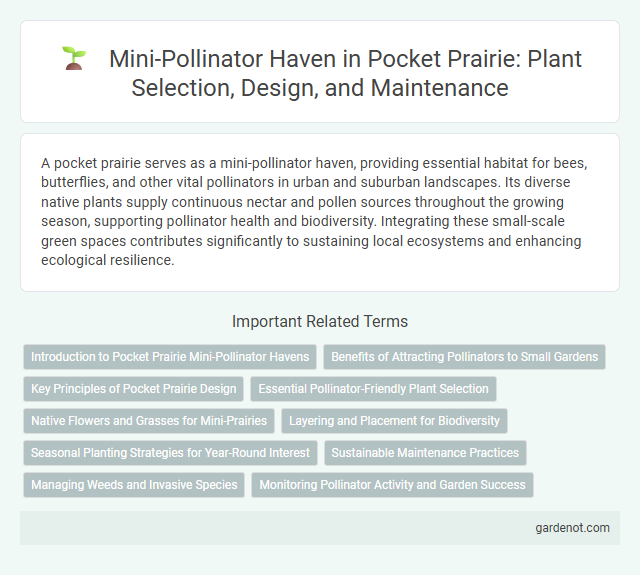A pocket prairie serves as a mini-pollinator haven, providing essential habitat for bees, butterflies, and other vital pollinators in urban and suburban landscapes. Its diverse native plants supply continuous nectar and pollen sources throughout the growing season, supporting pollinator health and biodiversity. Integrating these small-scale green spaces contributes significantly to sustaining local ecosystems and enhancing ecological resilience.
Introduction to Pocket Prairie Mini-Pollinator Havens
Pocket Prairie Mini-Pollinator Havens create small-scale habitats designed to support native pollinators like bees, butterflies, and hummingbirds. These havens feature diverse, nectar-rich plants that bloom across seasons, ensuring continuous food sources. By incorporating native wildflowers and grasses, they help restore ecological balance and boost local biodiversity in urban and suburban areas.
Benefits of Attracting Pollinators to Small Gardens
Mini-pollinator havens in pocket prairies significantly boost local biodiversity by providing essential habitats for bees, butterflies, and other pollinators. These small gardens enhance pollination efficiency, leading to increased yields in nearby fruit and vegetable crops. Supporting pollinators also contributes to ecosystem health and resilience by sustaining native plant populations.
Key Principles of Pocket Prairie Design
Pocket prairie design centers on creating mini-pollinator havens by incorporating diverse native plant species that provide continuous blooms throughout the growing season. Emphasizing layered planting structures and habitat variety enhances shelter and food sources, supporting a wide range of beneficial insects. Efficient spatial arrangement and minimal maintenance align with ecological functions, promoting pollinator health and biodiversity within compact urban landscapes.
Essential Pollinator-Friendly Plant Selection
Pocket prairies thrive by incorporating essential pollinator-friendly plants such as milkweed, coneflowers, and goldenrod, which provide vital nectar and pollen sources for bees, butterflies, and native pollinators. Selecting diverse native species enhances habitat resilience and supports a broad range of pollinator species throughout the growing season. Proper plant selection ensures sustained pollination services, contributing to ecosystem health and biodiversity in small-scale urban or suburban green spaces.
Native Flowers and Grasses for Mini-Prairies
Native flowers and grasses form the cornerstone of a mini-pollinator haven, providing essential nectar and pollen sources for bees, butterflies, and other beneficial insects. Species such as purple coneflower (Echinacea purpurea), black-eyed Susan (Rudbeckia hirta), and little bluestem grass (Schizachyrium scoparium) create diverse habitats that support pollinator health and biodiversity. Establishing these native plants in mini-prairies enhances ecosystem resilience and promotes natural pest control through attracting a variety of pollinator species.
Layering and Placement for Biodiversity
Layering and strategic placement in mini-pollinator havens maximize biodiversity by creating diverse microhabitats that support varied pollinator species. Utilizing vertical layers with native flowering plants, ground covers, and shrubs ensures continuous bloom cycles and shelter throughout seasons. Positioning these layers near water sources and pollinator pathways enhances habitat connectivity and resource availability for bees, butterflies, and other essential pollinators.
Seasonal Planting Strategies for Year-Round Interest
Creating a mini-pollinator haven in a pocket prairie involves selecting a diverse array of native perennials and annuals that bloom sequentially throughout the seasons, providing continuous nectar and pollen sources. Incorporating early-blooming species like Crocus and Willow catkins supports pollinators emerging in spring, while summer flowering plants such as Echinacea and Milkweed sustain activity during warmer months. Late-season blossoms like Asters and Goldenrod ensure food availability into fall, promoting year-round pollinator health and garden vibrancy.
Sustainable Maintenance Practices
Mini-pollinator havens within pocket prairies thrive through sustainable maintenance practices such as native plant selection, minimal soil disturbance, and seasonal mowing timed to support pollinator life cycles. Incorporating organic pest management and promoting biodiversity enhance ecosystem resilience while reducing chemical inputs. These practices create a balanced habitat that sustains pollinator populations and boosts local ecological health.
Managing Weeds and Invasive Species
Managing weeds and invasive species in a pocket prairie is crucial to maintaining a healthy mini-pollinator haven. Implement targeted removal techniques such as hand-pulling invasive plants and applying organic herbicides to minimize competition for native flowers that support pollinators. Regular monitoring and adaptive management promote biodiversity, ensuring optimal conditions for pollinators like bees, butterflies, and hummingbirds.
Monitoring Pollinator Activity and Garden Success
Monitoring pollinator activity in a mini-pollinator haven involves tracking species diversity, visitation rates, and foraging behavior to assess ecosystem health. Consistent data collection on pollen transfer efficiency and plant bloom success helps gauge garden productivity and pollination effectiveness. Utilizing digital tools and field surveys enables timely adjustments in plant selection and habitat structure to maximize pollinator support and biodiversity.
Mini-pollinator haven Infographic

 gardenot.com
gardenot.com